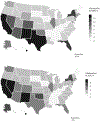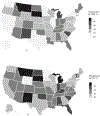Beyond Black and White: Mapping Misclassification of Medicare Beneficiaries Race and Ethnicity
- PMID: 32633665
- PMCID: PMC8602956
- DOI: 10.1177/1077558720935733
Beyond Black and White: Mapping Misclassification of Medicare Beneficiaries Race and Ethnicity
Abstract
The Centers for Medicare and Medicaid Services administrative data contains two variables that are used for research and evaluation of health disparities: the enrollment database (EDB) beneficiary race code and the Research Triangle Institute (RTI) race code. The objective of this article is to examine state-level variation in racial/ethnic misclassification of EDB and RTI race codes compared with self-reported data collected during home health care. The study population included 4,231,370 Medicare beneficiaries who utilized home health care services in 2015. We found substantial variation between states in Medicare administrative data misclassification of self-identified Hispanic, Asian American/Pacific Islander, and American Indian/Alaska Native beneficiaries. Caution should be used when interpreting state-level health care disparities and minority health outcomes based on existing race variables contained in Medicare data sets. Self-reported race/ethnicity data collected during routine care of Medicare beneficiaries may be used to improve the accuracy of minority health and health disparities reporting and research.
Keywords: Medicare; ethnicity; health disparities; minority health; race; state-level.
Conflict of interest statement
Declaration of Conflicting Interests: The author(s) declared no potential conflicts of interest with respect to the research, authorship, and/or publication of this article.
Figures




References
-
- Argeo L (2009). Asturian West Virgina. Goldenseal, 14–18. Reprint available at https://tracesofspainintheus.org/west-va/spelter/
-
- Avalere. (2015). Home Health Chartbook 2015: Prepared for the Alliance for Home Health Quality and Innovation. https://ahhqi.org/images/uploads/AHHQI_2015_Chartbook_FINAL_October.pdf
-
- Beechert ED (1985). Working in Hawaii: A Labor History. University of Hawaii Press.
Publication types
MeSH terms
Grants and funding
LinkOut - more resources
Full Text Sources
Medical

